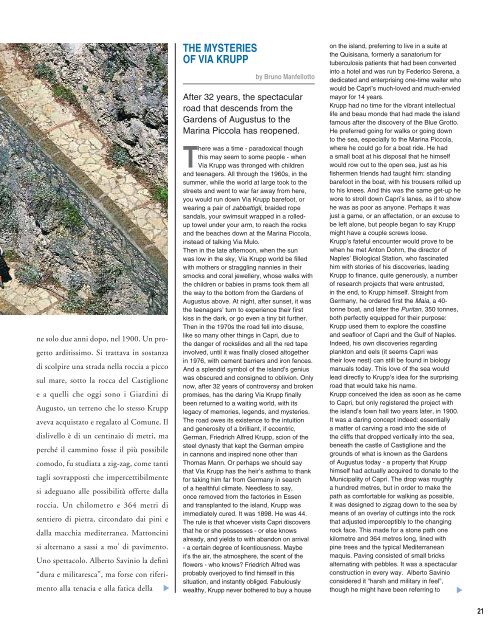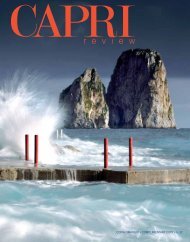COPIA OMAGGIO ⢠COMPLIMENTARY COPY EDIZIONI PRC
COPIA OMAGGIO ⢠COMPLIMENTARY COPY EDIZIONI PRC
COPIA OMAGGIO ⢠COMPLIMENTARY COPY EDIZIONI PRC
You also want an ePaper? Increase the reach of your titles
YUMPU automatically turns print PDFs into web optimized ePapers that Google loves.
ne solo due anni dopo, nel 1900. Un progetto<br />
arditissimo. Si trattava in sostanza<br />
di scolpire una strada nella roccia a picco<br />
sul mare, sotto la rocca del Castiglione<br />
e a quelli che oggi sono i Giardini di<br />
Augusto, un terreno che lo stesso Krupp<br />
aveva acquistato e regalato al Comune. Il<br />
dislivello è di un centinaio di metri, ma<br />
perché il cammino fosse il più possibile<br />
comodo, fu studiata a zig-zag, come tanti<br />
tagli sovrapposti che impercettibilmente<br />
si adeguano alle possibilità offerte dalla<br />
roccia. Un chilometro e 364 metri di<br />
sentiero di pietra, circondato dai pini e<br />
dalla macchia mediterranea. Mattoncini<br />
si alternano a sassi a mo’ di pavimento.<br />
Uno spettacolo. Alberto Savinio la definì<br />
“dura e militaresca”, ma forse con riferimento<br />
alla tenacia e alla fatica della<br />
<br />
THE MYSTERIES<br />
OF VIA KRUPP<br />
by Bruno Manfellotto<br />
After 32 years, the spectacular<br />
road that descends from the<br />
Gardens of Augustus to the<br />
Marina Piccola has reopened.<br />
There was a time - paradoxical though<br />
this may seem to some people - when<br />
Via Krupp was thronged with children<br />
and teenagers. All through the 1960s, in the<br />
summer, while the world at large took to the<br />
streets and went to war far away from here,<br />
you would run down Via Krupp barefoot, or<br />
wearing a pair of zabbattigli, braided rope<br />
sandals, your swimsuit wrapped in a rolledup<br />
towel under your arm, to reach the rocks<br />
and the beaches down at the Marina Piccola,<br />
instead of talking Via Mulo.<br />
Then in the late afternoon, when the sun<br />
was low in the sky, Via Krupp world be filled<br />
with mothers or straggling nannies in their<br />
smocks and coral jewellery, whose walks with<br />
the children or babies in prams took them all<br />
the way to the bottom from the Gardens of<br />
Augustus above. At night, after sunset, it was<br />
the teenagers’ turn to experience their first<br />
kiss in the dark, or go even a tiny bit further.<br />
Then in the 1970s the road fell into disuse,<br />
like so many other things in Capri, due to<br />
the danger of rockslides and all the red tape<br />
involved, until it was finally closed altogether<br />
in 1976, with cement barriers and iron fences.<br />
And a splendid symbol of the island’s genius<br />
was obscured and consigned to oblivion. Only<br />
now, after 32 years of controversy and broken<br />
promises, has the daring Via Krupp finally<br />
been returned to a waiting world, with its<br />
legacy of memories, legends, and mysteries.<br />
The road owes its existence to the intuition<br />
and generosity of a brilliant, if eccentric,<br />
German, Friedrich Alfred Krupp, scion of the<br />
steel dynasty that kept the German empire<br />
in cannons and inspired none other than<br />
Thomas Mann. Or perhaps we should say<br />
that Via Krupp has the heir’s asthma to thank<br />
for taking him far from Germany in search<br />
of a healthful climate. Needless to say,<br />
once removed from the factories in Essen<br />
and transplanted to the island, Krupp was<br />
immediately cured. It was 1898. He was 44.<br />
The rule is that whoever visits Capri discovers<br />
that he or she possesses - or else knows<br />
already, and yields to with abandon on arrival<br />
- a certain degree of licentiousness. Maybe<br />
it’s the air, the atmosphere, the scent of the<br />
flowers - who knows? Friedrich Alfred was<br />
probably overjoyed to find himself in this<br />
situation, and instantly obliged. Fabulously<br />
wealthy, Krupp never bothered to buy a house<br />
on the island, preferring to live in a suite at<br />
the Quisisana, formerly a sanatorium for<br />
tuberculosis patients that had been converted<br />
into a hotel and was run by Federico Serena, a<br />
dedicated and enterprising one-time waiter who<br />
would be Capri’s much-loved and much-envied<br />
mayor for 14 years.<br />
Krupp had no time for the vibrant intellectual<br />
life and beau monde that had made the island<br />
famous after the discovery of the Blue Grotto.<br />
He preferred going for walks or going down<br />
to the sea, especially to the Marina Piccola,<br />
where he could go for a boat ride. He had<br />
a small boat at his disposal that he himself<br />
would row out to the open sea, just as his<br />
fishermen friends had taught him: standing<br />
barefoot in the boat, with his trousers rolled up<br />
to his knees. And this was the same get-up he<br />
wore to stroll down Capri’s lanes, as if to show<br />
he was as poor as anyone. Perhaps it was<br />
just a game, or an affectation, or an excuse to<br />
be left alone, but people began to say Krupp<br />
might have a couple screws loose.<br />
Krupp’s fateful encounter would prove to be<br />
when he met Anton Dohrn, the director of<br />
Naples’ Biological Station, who fascinated<br />
him with stories of his discoveries, leading<br />
Krupp to finance, quite generously, a number<br />
of research projects that were entrusted,<br />
in the end, to Krupp himself. Straight from<br />
Germany, he ordered first the Maia, a 40-<br />
tonne boat, and later the Puritan, 350 tonnes,<br />
both perfectly equipped for their purpose:<br />
Krupp used them to explore the coastline<br />
and seafloor of Capri and the Gulf of Naples.<br />
Indeed, his own discoveries regarding<br />
plankton and eels (it seems Capri was<br />
their love nest) can still be found in biology<br />
manuals today. This love of the sea would<br />
lead directly to Krupp’s idea for the surprising<br />
road that would take his name.<br />
Krupp conceived the idea as soon as he came<br />
to Capri, but only registered the project with<br />
the island’s fown hall two years later, in 1900.<br />
It was a daring concept indeed: essentially<br />
a matter of carving a road into the side of<br />
the cliffs that dropped vertically into the sea,<br />
beneath the castle of Castiglione and the<br />
grounds of what is known as the Gardens<br />
of Augustus today - a property that Krupp<br />
himself had actually acquired to donate to the<br />
Municipality of Capri. The drop was roughly<br />
a hundred metres, but in order to make the<br />
path as comfortable for walking as possible,<br />
it was designed to zigzag down to the sea by<br />
means of an overlay of cuttings into the rock<br />
that adjusted imperceptibly to the changing<br />
rock face. This made for a stone path one<br />
kilometre and 364 metres long, lined with<br />
pine trees and the typical Mediterranean<br />
maquis. Paving consisted of small bricks<br />
alternating with pebbles. It was a spectacular<br />
construction in every way. Alberto Savinio<br />
considered it “harsh and military in feel”,<br />
though he might have been referring to<br />
<br />
21



